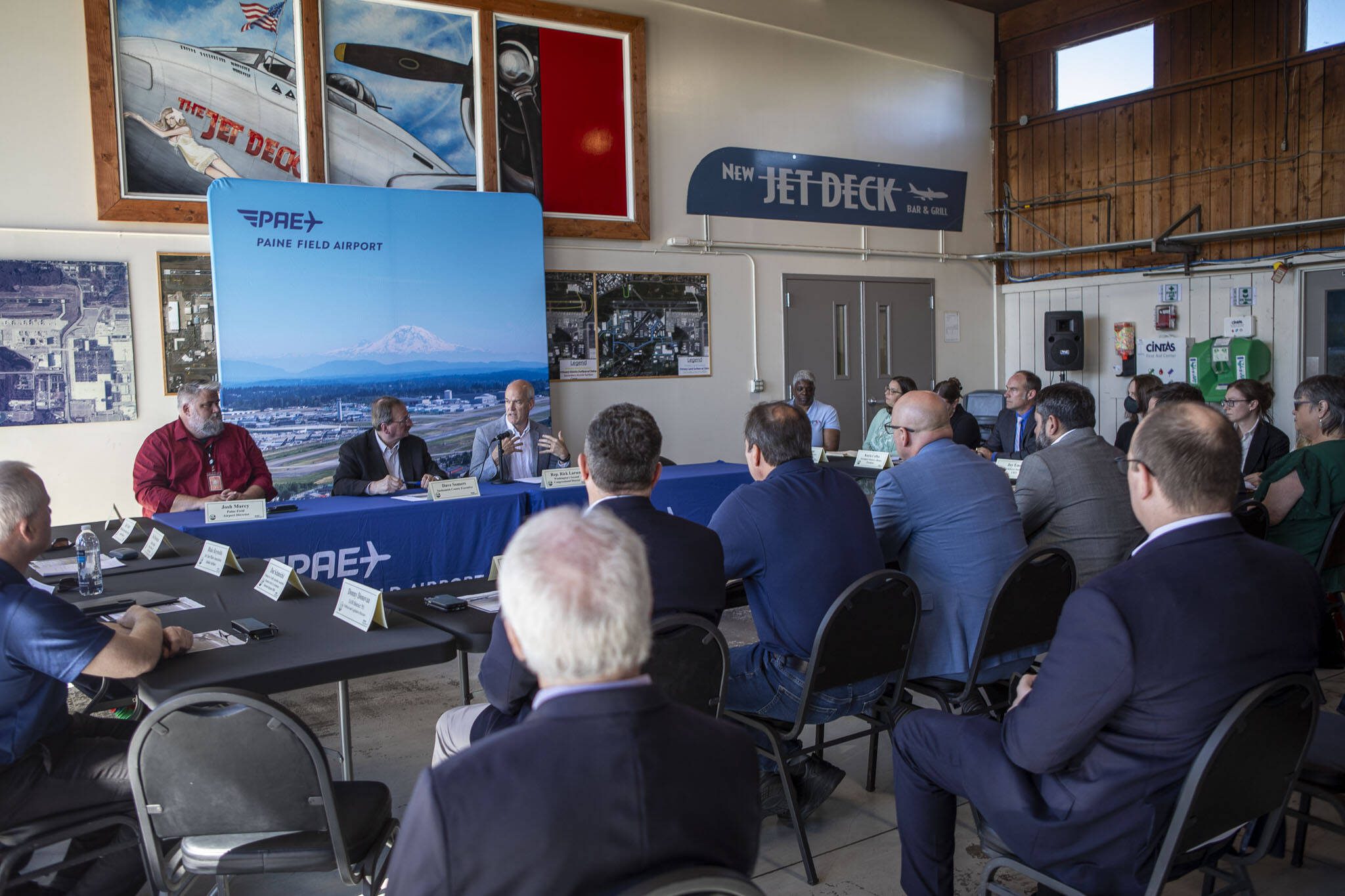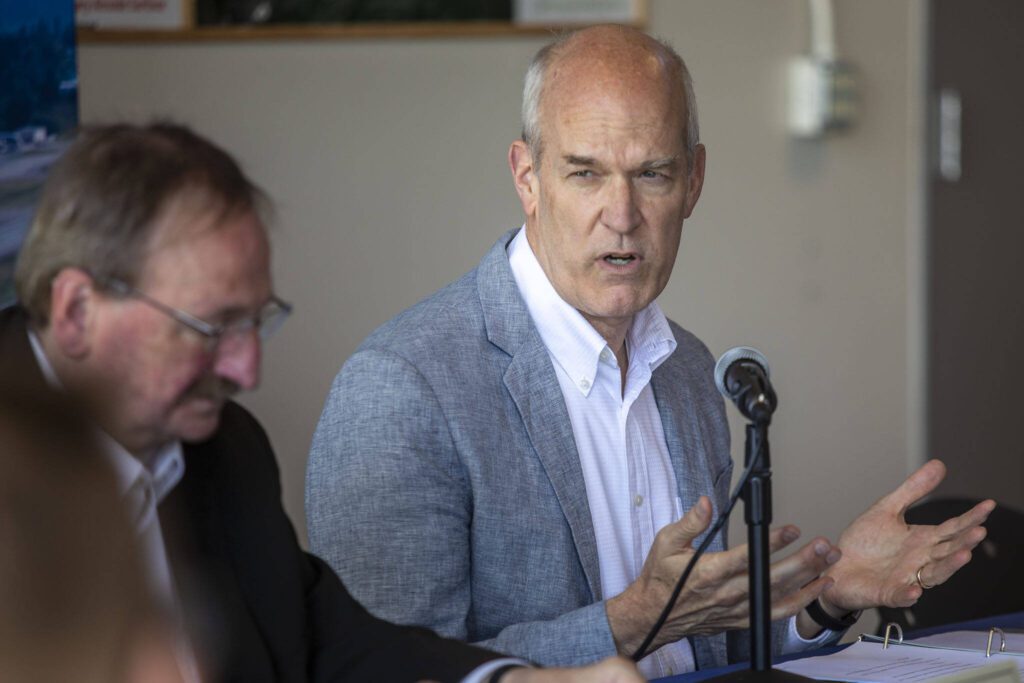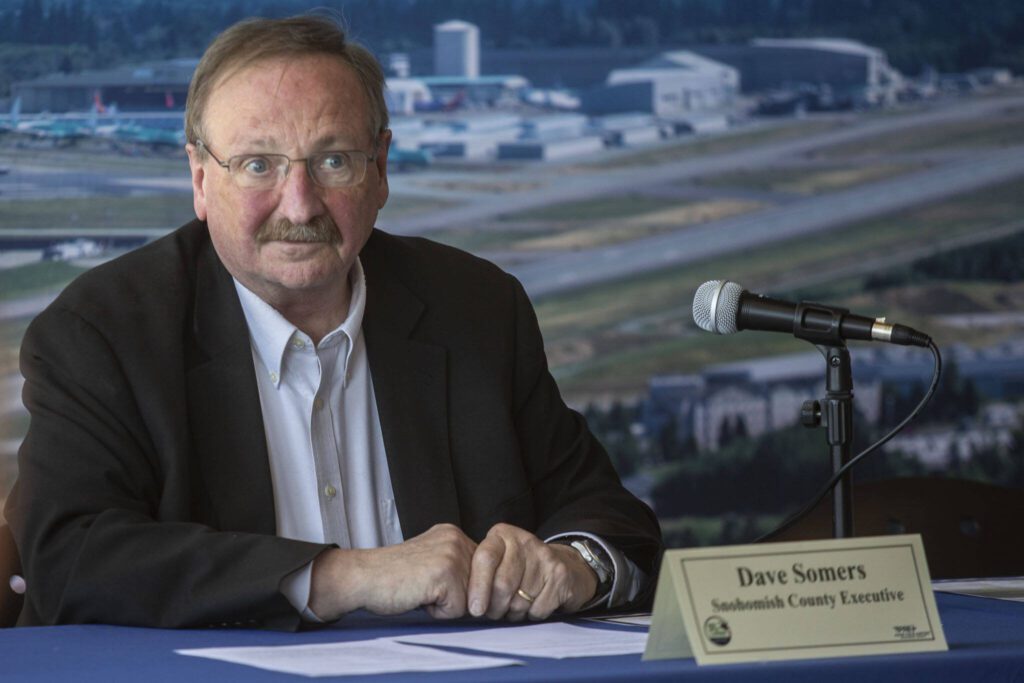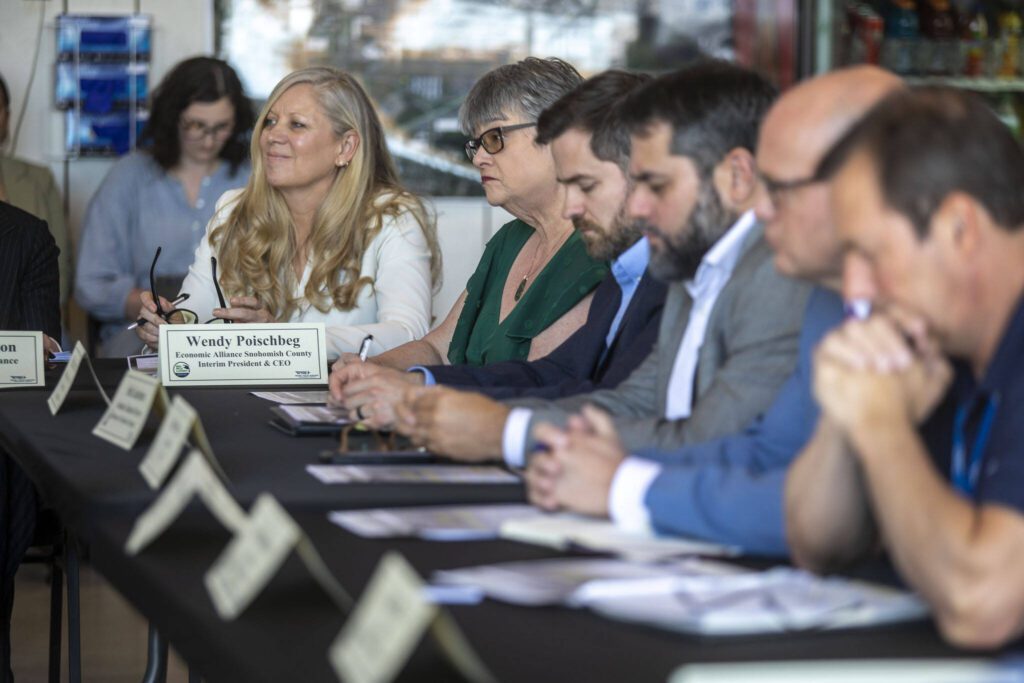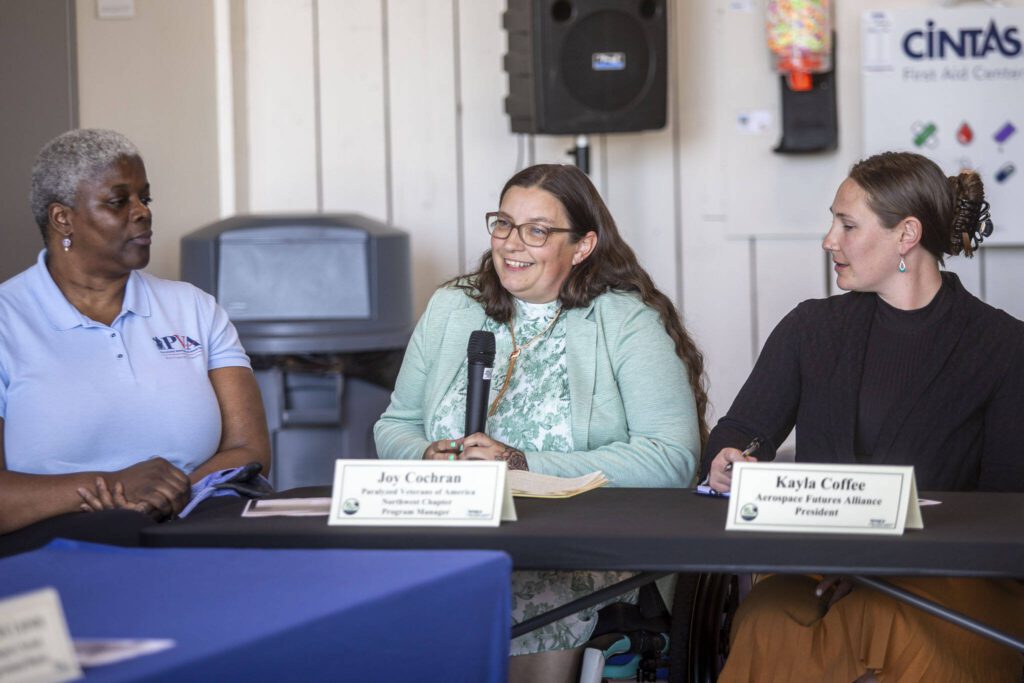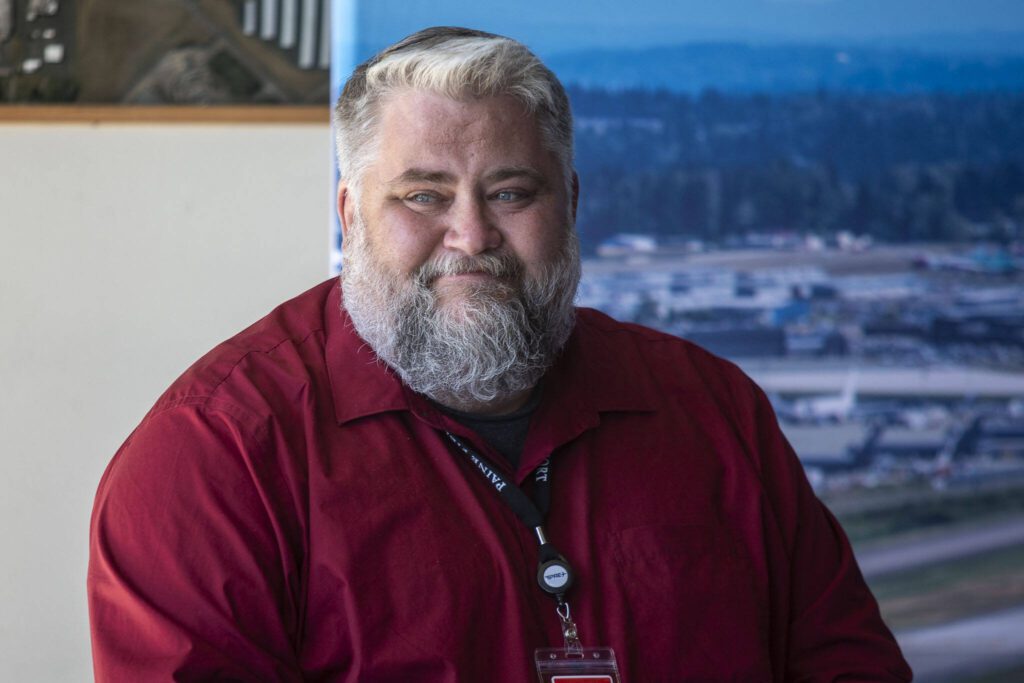EVERETT — Paine Field plans to repave its main runway and, hopefully, increase staffing at the airport’s air traffic control tower, thanks to the Federal Aviation Administration Reauthorization Act, signed into law last month by President Joe Biden.
Those improvements and others are expected to boost the Snohomish County-owned airport’s function and safety, and support the airport’s “big tenants — Boeing, Aviation Technical Services and commercial airline service,” airport director Joshua Marcy told a gathering Thursday of more than 50 people.
The $105 billion bill, whose passage was championed by Rep. Rick Larsen, D-Everett, and Sen. Maria Cantwell, D-Washington, funds the FAA for the next five years.
At a roundtable discussion Thursday, dozens of local aerospace executives and labor leaders learned how the law will benefit Paine Field, as well as the region’s aerospace industry.
The act includes new safety rules and consumer protections for airline passengers. It provides money to hire new air traffic controllers, train new pilots and airplane mechanics and advance the development of sustainable aviation fuel and alternative aircraft technologies.
It also gives the Boeing 767 freighter a five-year exemption from new emissions standards. The company would have been forced to end production of the Everett-built jet in 2027, if not for the extension. Under the provision, Boeing can continue to build the 767 through 2033.
Larsen, the bill’s lead negotiator and ranking Democrat on the Transportation and Infrastructure Committee, led the 90-minute roundtable. He was joined by airport director Marcy and County Executive Dave Somers.
Together, they heard from a score of aerospace firms with Snohomish County ties: Boeing; Aviation Technical Services; Collins Aerospace; Alaska Airlines; ZeroAvia, which is developing hydrogen-electric powered airplanes; magniX, an electric powertrain developer; and Arlington’s Eviation Aircraft, which has built and flown an all-electric nine-seat airplane.
They also heard from members of the International Association of Machinists and Aerospace Workers District 751, the National Air Traffic Controllers Association and Air Line Pilots Association.
The event, held at a Paine Field maintenance hangar, was the perfect setting. Outside, Alaska Airlines passenger jets taxied to and from the main runway. Next to the hangar, mowers, snow plows and other runway equipment gleamed in the sun. FAA and airport dollars help pay for and maintain the fleet, Marcy noted.
Somers kicked off the discussion with a reminder: While Seattle-Tacoma International Airport generates $20 billion in economic activity each year, Paine Field produces three times that amount, $60 billion, according to a recent state Department of Commerce study.
“What Rick did in Congress to get this bill passed was monumental,” Marcy said. “This helps our airport and it also helps the whole industry grow.”
Larsen said the reauthorization helps create a “safer, cleaner and greener” aviation system over the next five years.
“It will help the U.S. maintain aviation leadership in safety and innovation and strengthen and diversify the workforce,” he added.
The act provides airports across the country with access to $4 billion each year in Airport Improvement Program dollars, an annual increase of $650 million over the previous budget. The additional money, Larsen said, is weighted toward funding projects at small- and medium-size airports like Paine Field.
Marcy’s wish list included funding to refurbish Paine Field’s main runway and FAA approval to extend the hours the control tower is staffed.
Also on the list, a grant that would help construct the Sustainable Aviation Fuel and Development Center at Paine Field, a joint venture between Snohomish County and Washington State University that will collect and test sustainable aviation fuel samples.
Between now and 2030, Marcy said the airport expects to “use about $80 to $100 million” in Airport Improvement Program money to resurface the main runway, which is nearing ‘the end of its useful life.”
The act also provides funding for the FAA to hire and several thousand more air traffic controllers: 1,800 this year and 2,000 in 2025. The agency currently employs more than 13,000 air traffic controllers.
“We’re definitely going to raise our hand for that, so we can hopefully extend the hours get more people in there,” Marcy said.
Paine Field’s FAA-operated control tower is currently staffed 7 a.m. to 9 p.m. every day. However, the current staffing level “is not a safety issue,” Marcy said.
About three-quarters of the nation’s 20,000 airports don’t have a control tower or don’t offer 24-hour air traffic control.
“While our tower maybe closed, pilots have the opportunity to communicate with TRACON,” Marcy said. TRACON, or Terminal Radar Approach Control, are FAA air traffic controllers who generally operate within a 30- to 50-mile radius of an airport.
Blake Reynolds, an Alaska Airlines pilot and member of the Air Line Pilots Association, applauded the push to hire more air traffic controllers.
“We desperately need air traffic controllers. Every single day they do a killer job out there,” Reynolds said. “I know they’re working their butts off to make sure that everything stays safe.”
The law also provides $60 million a year for workforce development programs to train new pilots and airplane technicians and mechanics.
For companies like Boeing and Aviation Technical Services that repairs commercial jets at its enormous Paine Field hangar, the struggle to hire and retain skilled workers is an ongoing challenge.
Everett-based Aviation Technical Services, which runs a paid, in-house apprenticeship program, has graduated 200 apprentices since the program’s 2018 launch. Still, more skilled workers are needed, said Seth Jacobsen, the company’s director of technical training.
Boeing’s government relations manager Rich White said the planemaker is trying “as early as possible to get high school students interested in aviation.” The company emphasizes to students, “These are careers not just jobs,” White said.
Both Boeing and ATS welcomed the added funding for workforce initiatives, which includes money to recruit and retain workers from underrepresented communities.
Reed Macdonald, CEO of magniX, an Everett company that’s developing electric propulsion systems for aircraft, noted the FAA bill includes money to help create the infrastructure and training required to support the advent of hydrogen-electric and electric-powered airplanes.
“It takes a lot of preparation now to be prepared for these new technologies,” Macdonald said.
Highlights of the FAA Act
• Each year, U.S. airports will have access to $4 billion in Airport Improvement Program dollars.
• Provides $60 million a year to help train pilots and aviation maintenance and manufacturing workers. Of the amount, 20% is reserved from the Willa Brown Aviation Education Program to recruit and retain underrepresented communities.
• Creates a new $200 million grant program to fund runway safety projects.
• Authorizes at least $150 million a year in Airport Improvement Program funds for airports to reduce noise and carbon emissions.
• Studies how to reduce the harm from turbulence, radiation exposure and extreme temperatures on passengers and flight crews.
• Requires airlines to install 25-hour cockpit voice recorders.
• Requires airlines to allow passengers to sit next to their young child whenever possible.
• Creates an FAA task force to help prevent assaults against airline employees.
Janice Podsada; jpodsada@heraldnet.com; 425-339-3097; Twitter: @JanicePods.
Talk to us
> Give us your news tips.
> Send us a letter to the editor.
> More Herald contact information.
